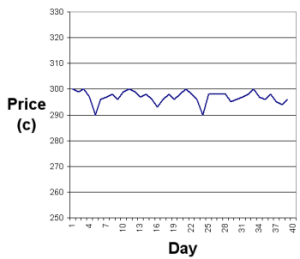What Can You Learn From Jesse Livermore’s PIVOTAL Points Trading System?
- March 8, 2016
-
W. Crowder
- Stock Trading Tips
- No Comments
Who Was Jesse Livermore and How Did He Come Up With His Pivotal Points Trading Strategy and System?
“The game of speculation is the most uniformly fascinating game in the world. But it is not a game for the stupid, the mentally lazy, the man of inferior emotional balance, or for the get-rich-quick adventurer. They will die poor. It took me five years to learn to play the game intelligently enough to make big money when I was right.”” — quotes from Reminiscences of a Stock Operator.
These are the words of the man who Time Magazine once described as the most incomparable living United States based stock trader, Jesse Livermore. The story of Livermore tells the tale of how he transformed himself from humble trading firm office boy to Wall Street Legend whose wealth was so vast that he owned the second largest yacht in the world. The lessons he learned and shared on successful trading along with his life’s disasters and triumphs have been called the most titillating of all fantastic rags to riches Wall Street stories ever told. Even to this day decades after his death, numerous commodity and stock traders owe their successes to Jesse Livermore, along with a sincere debt of true gratitude for sharing these success stories with them.

What is more interesting still is the fact that the techniques which he revealed to traders around the globe were not only relevant for his trading day and age, but they have lasted and continued to be taught over many decades span of time. This is because the rules which he so effectively developed and utilized to make literally tens of millions of dollars still work today, providing that you do as he suggested and remain faithful to them. Livermore was no stranger to violating his own sacred rules, as when he lost his whole vast fortune on more than one occurrence for foolishly ignoring his own rules. Most impressive about Jesse Livermore perhaps remains the fact that he became a truly self-made wealthy man by trading with and growing his own money, and not that of other individuals and investors, as with so many present day hedge funds, investment banks, and their mogul overseers.
Just How Successful in Dollar Terms Was Jesse Livermore as a Private Trader and Investor?
This is difficult to pin down exactly as the value of the dollar has plunged so dramatically between his own time and ours today. The answer depends on how you measure the minimally $100 million he amassed by the peak of his career in 1929. By any measurement that you utilize, Jesse Livermore’s personal fortune peaked at a current day dollar amount of as low as $1.1 billion and as much as $14 billion.
Economists generally give the 1929 dollar a value of between ten and more than 100 times what it is now worth. If you measured it in terms of gold;s value then and now, the precious metal is worth over 60 times more than it was in the 1920’s, meaning that his fortune would amount to over $6 billion today. By the standard of the official Consumer Price Index, it would amount to $1.27 billion. According to the nominal GDP per capita comparison of his wealth, it would translate to $5.51 billion today. Measuring his money as a percentage of the then-relative share of GDP would put him at a staggering $14 billion as measured against today’s relative share of GDP.
By any measurement that you utilize, he was among the handful of very richest men on earth in his own time, just as he would be richer than Queen Elizabeth, a peer of Donald Trump’s, and not far behind Bill Gates if measured in today’s dollars. Certainly he lived like American Royalty, as his daughter in law claimed that they had two fabulous apartments in New York City, private railway cars and two enormous private yachts (one of which was second in the world only in size to JP Morgan’s private yacht), and at least four other houses around the United States at the time, with a full-time staff of 25 servants maintained year round at each property that they owned. They were constantly sailing to Europe in their mega-yacht, where they actually spent a great deal of time. Even the rich today do not live so fabulously well as Jesse Livermore and his family did in the 1920’s.
The Wisdom of Jesse Livermore and His Pivotal Points Trading Methods System
Livermore published a book which was an interesting look at his personal methods and trading methodology. In keeping with his flair for the dramatic, it was not simply a “here’s how I did it” standard boring tell-all on financial investments and trading. Instead, he engaged in an almost fiction-styled series of interviews in his Reminiscences of a Stock Operator with “Lawrence Livingstone” (which was really a pseudonym for himself, Jesse Livermore). In this often-gripping story, the financial journalist Edwin Lefèvre went straight to the heart of the trading strategy and investing psychology of a master stock market trader who was suspiciously like himself in every way.
The centerpiece of Jesse Livermore’s unparalleled trading prowess lay in the impressive set of skills he had picked up while still 14 years old. He would transfer the stock prices in the office he worked at from ticker tape to a quote board. Doing this, he learned the means to deduce the probable future moves of any given stock’s prices. Not bad for a kid who never even attended high school.
Here is a sample of his powerful trading insight and thought as demonstrated in his written wisdom:
Livermore said, “To invest or speculate successfully, one must form an opinion as to what the next move of importance will be in a given stock.”
“Speculation is nothing more than anticipating coming movements.”
“In order to anticipate correctly, one must have a definite basis for that anticipation.”
One of Livermore’s most revolutionary investing ideas proved to be his sincere belief that if a person believed a stock would go in a certain direction and amount, he or she should get into the trade as soon as possible after the stock market had confirmed this person’s theory, and not before.
What Patterns Did Jesse Livermore Look For?
Jesse had his own favorite types of stocks to follow and trade. He preferred those issues where the price moved in an obvious trend pattern. Those stocks that had prices which showed little to no strong trend and only smaller price changes were of no interest to the investing guru. The charts below demonstrate the types of stocks in which he had no interest, those which were trapped in a particular trading range:

The Pivotal Point Defined and Explained
The crux of Livermore’s system centered on patterns in prices that he attempted to identify. This is no longer a novel idea nine decades after his heyday, but at the time it was somewhat revolutionary in American stock market trading. Today a great number of modern day traders plot such elements as price and volume against time using charts. Jesse was fairly unique in the fact that he did not rely on nor employ charts really. He preferred to observe and analyze the numbers directly. This is one of the major ways in which he separated himself from traders of his own day and ours today as well.
Jesse Livermore famously wrote:
“Whenever I have had the patience to wait for the market to arrive at what I call a Pivotal Point before I started to trade; I have always made money in my operations.”
Look at this chart to get a better idea of this pivotal point concept which he is discussing:
As you can see, in this chart a pivotal point has been attained. Previously, the stock’s price had been trending to the downside but then it rallied from its prior low of 40 cents. For whatever reason, such a rally was unsustainable and the stock returned to near its low of 40 cents once again. This means that the 40 cents line in the proverbial sand has evolved into what Jesse affectionately called a “pivotal point.” From this point, any major move either higher or lower off of this pivotal point would then be traded by Jesse Livermore.
As an example, if the stock broke below 37 cents, then Jesse would simply sell it short. If instead it rallied above 43 cents, he would buy the stock. He would watch the ensuing price action with caution after buying, since the prior high of the past rally was at 49 cents, yet another pivotal point though one to the upside this time. If the price was again unable to surpass the 49 cent pivotal point by around 3 cents, then Jesse Livermore would simply abandon the trade.
Regarding the importance of timing such trades carefully, Livermore once said:
“I never benefited much from a move if I did not get in at somewhere near the beginning of the move. And the reason is that I missed the backlog of profit which is very necessary to provide the courage and patience to sit through a move until the end comes – and to stay through any minor reactions or rallies which were bound to occur from time to time before the movement had completed its course.”
Jesse Livermore Always Looked For The Following Signs:
- At a move’s beginning, he sought confirmation of a significant and atypical number of shares volume traded.
- Then the price actions should more or less be in a single up or down direction for several days.
- There should subsequently be a normal reaction whereby volume dropped as compared with the higher volumes which were witnessed in the early stages of the initial trend, and this would be accompanied by the price action turning a little against the new trend.
- After only a day or two from the normal reaction, the subsequent volume ought to again rise with the price trend resuming alongside this volume improvement.
Livermore stated that if the pattern continues to be repeated, then the trade remains a safe bet. However, when deviation from the four step procedure appeared, this was a warning sign. With a failure in the pattern leading to the price going against its trend by more than only a little, this proved to be the crystal clear point to abandon the trade and get out while there was still a profit to be had.
In Conclusion
It is hard to argue against success in general, but it is nearly impossible to oppose the legendary, long-lasting, and far reaching levels of success that Jesse Livermore attained consistently. So long as he obeyed the rules of his own system, the man made more money than he knew what to do with in his life. On those rare occasions where he grew impatient or disobeyed his strategy, he lost the very same fortunes that he had spent a great amount of time building up. The telling signs of the validity of his strategy are that it still works today, nearly a hundred years after he originally formulated and proved it.
